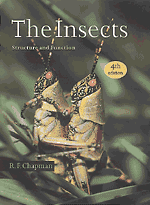Book contents
- Frontmatter
- Contents
- Preface
- Acknowledgments
- PART I The Head, Ingestion, Utilization and Distribution of Food
- PART II The Thorax and Locomotion
- PART III The Abdomen, Reproduction and Development
- 11 Abdomen
- 12 Reproductive system: male
- 13 Reproductive system: female
- 14 The egg and embryology
- 15 Postembryonic development
- PART IV The Integument, Gas Exchange and Homeostasis
- PART V Communication
- Taxonomic index
- Subject index
13 - Reproductive system: female
Published online by Cambridge University Press: 05 June 2012
- Frontmatter
- Contents
- Preface
- Acknowledgments
- PART I The Head, Ingestion, Utilization and Distribution of Food
- PART II The Thorax and Locomotion
- PART III The Abdomen, Reproduction and Development
- 11 Abdomen
- 12 Reproductive system: male
- 13 Reproductive system: female
- 14 The egg and embryology
- 15 Postembryonic development
- PART IV The Integument, Gas Exchange and Homeostasis
- PART V Communication
- Taxonomic index
- Subject index
Summary
ANATOMY OF THE INTERNAL REPRODUCTIVE ORGANS
The female reproductive system consists of a pair of ovaries, which connect with a pair of lateral oviducts. These join to form a median oviduct opening posteriorly into a genital chamber. Sometimes the genital chamber forms a tube, the vagina, and this is often developed to form a bursa copulatrix for reception of the penis. Opening from the genital chamber or the vagina is a spermatheca for storing sperm, and, frequently, a pair of accessory glands is also present (Fig. 13.1).
Review: Martoja, 1977
Ovary The two ovaries lie in the abdomen above or lateral to the gut. Each consists of a number of egg-tubes, or ovarioles, comparable with the testis follicles in the male. The oocytes develop in the ovarioles. The ovaries of Collembola are probably not homologous with those of insects, but are sac-like with a lateral germarium and no ovarioles.
The number of ovarioles in an ovary varies in relation to size and life style of the insect as well as its taxonomic position. In general, larger species within a group have more ovarioles than small ones; thus small grasshoppers commonly have only four ovarioles in each ovary, while larger ones may have more than 100. Similarly, in the higher Diptera, Drosophila has 10–30 ovarioles in each ovary, whereas Calliphora has about 100. By contrast, most Lepidoptera have four ovarioles on each side irrespective of their size.
- Type
- Chapter
- Information
- The InsectsStructure and Function, pp. 295 - 324Publisher: Cambridge University PressPrint publication year: 1998
- 6
- Cited by



